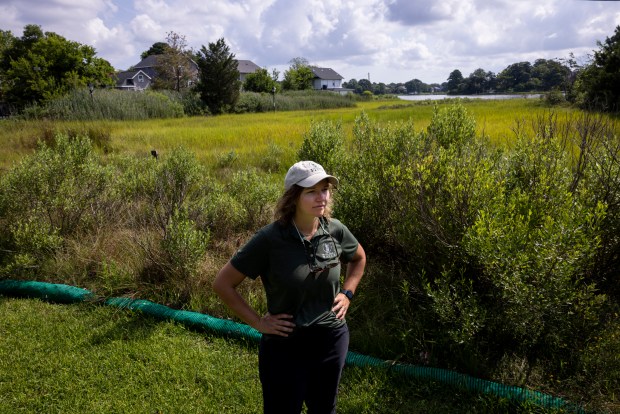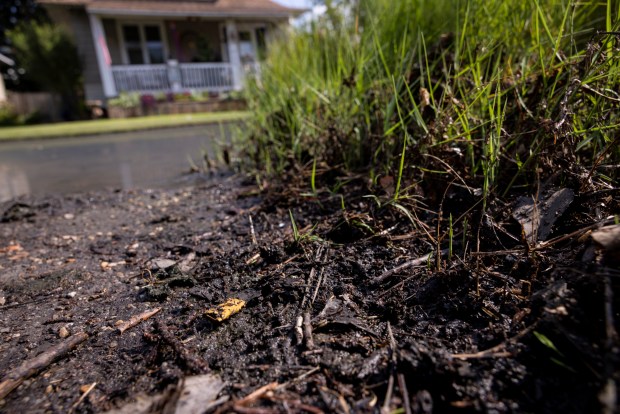Flooding is nothing new to Hampton Roads.
With land subsidence, sea-level rise and stronger storms creating the perfect cocktail for more frequent and severe flooding, cities across the region are working on strategies to mitigate risk. Multibillion-dollar infrastructure projects are in the works across the region. Meanwhile, some homeowners take steps such as filling basements or raising foundations for resiliency.
But some in Hampton Roads — and other climate-vulnerable parts of the country — are asking whether another option should be considered. At what point does it make better sense to abandon areas that repeatedly flood?
The concept is called managed retreat and involves moving inhabitants out of locations threatened by climate change. It’s already taking place on a limited scale in some Hampton Roads cities.
 Mary-Carson Stiff with Wetlands Watch at the end of LaValette Avenue in Norfolk, Virginia, on July 14, 2025. (Billy Schuerman / The Virginian-Pilot)
Mary-Carson Stiff with Wetlands Watch at the end of LaValette Avenue in Norfolk, Virginia, on July 14, 2025. (Billy Schuerman / The Virginian-Pilot)
What is managed retreat?
Large-scale resilience projects have popped up across Hampton Roads to better handle storms. From new tide gates in Virginia Beach to the sea wall planned for Norfolk, many of these projects involve fortifying existing development, such as homes and businesses.
Managed retreat takes a different approach. Instead of adjusting or building new infrastructure, retreating involves formally moving people or infrastructure away from areas impacted by these climate issues. Much of climate-related retreat happens organically — homeowners on their own decide the risk isn’t worth staying. But managed retreat is an organized and strategic effort to migrate.
“Managed retreat is proactively getting people out of harm’s way before a flood can hurt them again,” said Jessica Whitehead, executive director at the Institute for Coastal Adaptation and Resilience at Old Dominion University.
Most managed retreat is voluntary, often coming in the form of buyouts. In these cases, cities, states or private entities offer property owners money to obtain their property. In many cases, these properties are then turned into natural landscape, or more resilient infrastructure could be built.
Some cities in Hampton Roads have performed voluntary acquisitions using money from the Federal Emergency Management Agency, and local resiliency offices do these sporadically and in targeted areas. But acquisitions have happened infrequently — experts say that could be due to restrictions on how federal funding can be used and how long the process can take.
Newport News has completed 85 voluntary buyouts — the majority in the Salters Creek area, which has historically been most prone to tidal and storm surge flooding. Virginia Beach has done one acquisition project that bought two properties in Windsor Woods, though flood protection was not the only reason, a city spokesperson said. Chesapeake has completed 49 acquisitions using FEMA dollars. Most of Chesapeake’s FEMA property acquisition projects have been in the city’s floodplain, which is almost 50 square miles.
In Norfolk, five flood-prone properties were bought through FEMA’s Hazard Mitigation Assistance program. Each property was considered a repetitive loss or severe repetitive loss, and all structures were demolished. After demolition, the area is considered open space in perpetuity.
“Because of the strict criteria and permanent land-use restrictions involved, Norfolk applies this approach selectively, typically in cases where the property is very close to the water and presents significant long-term risk,” said Kelly Straub, a city spokesperson. “Each potential buyout is carefully evaluated to determine whether acquisition or elevation is the most appropriate mitigation strategy.”
Where it’s worked before
In areas of large-scale managed retreats, the vast majority have been voluntary.
After Grundy flooded in 1977, funding from the Army Corps of Engineers and the Virginia Department of Transportation was used to relocate a large chunk of the population to higher ground. Major flooding was happening about every 20 years in the southwestern Virginia town. It sat near the Levisa River, and during major events, more than 5 feet of water would run through downtown, leaving mud and dead snakes behind. By 1983, state leaders were working to get funding together for the relocation.
The coal town’s project wasn’t without controversy — some thought it was too risky for the cost of $177 million. During the first phase, the Army Corps paid most of Grundy’s building owners and tore down the structures. Officials built a new commercial district across the river. The mountainous terrain meant there wasn’t anywhere above the flood plain to build, so the Army Corps bulldozed part of a mountain to create a 17-acre parcel of flat land.
VDOT also rerouted the road through Grundy, and built the highway a levee, which was completed in 2023.
In Cedar Rapids, Iowa, a flood in 2008 inundated 14% of the city, affecting 7,000 land parcels and more than 5,300 homes. Officials used funds from the U.S. Department of Housing and Urban Development Community Development Block Grant Program to offer buyouts to owners of more than 1,300 damaged houses. The process, which began in 2008, offered 107% of the home’s pre-flood cost and was completed in 2014.
One of the only examples of a forced retreat happened in Texas after Hurricane Harvey. In 2020, Harris County mandated buyouts after receiving HUD relief funding. County officials noted the area of Allen Field in Houston had flooded 12 times in the past four decades and felt that there were no infrastructure projects that would keep the area safe from future flooding.
Homes are reflected in a flooded area at the end of LaValette Avenue in Norfolk, Virginia, on July 14, 2025. (Billy Schuerman / The Virginian-Pilot)

Wax myrtle is light by sunlight in a wetland area at the end of LaValette Avenue in Norfolk, Virginia, on July 14, 2025. (Billy Schuerman / The Virginian-Pilot)

Sturdy Bulrush hangs in the sunlight in a wetland area at the end of LaValette Avenue in Norfolk, Virginia, on July 14, 2025. (Billy Schuerman / The Virginian-Pilot)
Show Caption
1 of 3
Homes are reflected in a flooded area at the end of LaValette Avenue in Norfolk, Virginia, on July 14, 2025. (Billy Schuerman / The Virginian-Pilot)
Expand
Flood risks in Hampton Roads
Climate disasters such as hurricanes and wildfires are forecast to get worse, and recovery is getting more expensive. The National Oceanic and Atmospheric Administration reported that in 2024, there were 27 individual weather and climate disasters with at least $1 billion in damages, trailing only the record-setting 28 events analyzed in 2023. The price tag was $182.7 billion.
Joshua Elliot, chief scientist of research nonprofit Renaissance Philanthropy, said the 1-in-100 year flood scenario cities use for planning infrastructure is becoming outdated. A study he conducted found generational floods could happen closer to every 30 years over the next couple decades. Resiliency planning can prompt difficult conversations about funding.
“It requires politicians and a public that are really willing to invest heavily in coastal resilience in order to avoid future risk,” he said. “Unfortunately, it comes to: Do I want to pay higher taxes, or do I want to take this hypothetical chance down the road? Oftentimes, we make the lower taxes choice.”
An analysis and online tool created by the Natural Resources Defense Council shows nearly 7,000 properties in Virginia had repeated claims for flood damage over 10 years. The majority were in Hampton Roads.
Across Hampton Roads, about 10% of those properties are not built in high-risk flood areas, but 30% of properties are uninsured against flood risk. Only about 7% have been mitigated to reduce risks, which could include infrastructure improvements, home elevations and voluntary buyouts.
Flood insurance is sold separately from homeowners insurance, and many property owners use publicly funded insurance such as the National Flood Insurance Program to cover their homes from risk. As risks increase, the price of insurance also increases, and many have called on FEMA to make insurance more affordable, said Anna Weber, an NRDC senior policy analyst.
Local experts think some areas of Hampton Roads could benefit from a hard look at managed retreat. Mary-Carson Stiff, executive director of Wetlands Watch, said properties that border rivers or creeks are particularly vulnerable, with some losing backyards and front lawns to encroaching wetlands.
In Norfolk, near the Virginia Zoo, wetlands are slowly working their way up La Valette Avenue. Much of the land near properties has converted to water, bringing tall grasses like phragmites to reach at least 5 feet tall. At the 200 block, the paved road ends, swallowed by water. A few lots have already been acquired by the city and turned into a small grove of salt-tolerant trees, but several homes remain.
Virginia has more limited flood disclosure laws compared to other states, meaning in some cases, a homeowner may not know how vulnerable a property is to flooding. Legislation that would have required flood risk disclosures by sellers and landlords was introduced in Virginia’s General Assembly in 2024 but did not advance.
“All of these issues are so closely connected,” Weber said. “If you don’t have good flood disclosure requirements in place, you buy a home and no one tells you that it’s at risk of flooding. Then, you don’t get flood insurance. Now you have no financial safety net when your home floods, and you’re left with very few options. What are you going to do?
“Your best option might be to wait for a buyout, but that might not be available. It might not give you the money that you need to actually move on with your life.”
Challenges to retreat
The cost to build resilient infrastructure is expensive. Norfolk is poised to spend $2.6 billion on a series of resiliency structures such as floodwalls and surge barriers. The federal government plans to fund 65% of the project, leaving the city and state to pay for the remaining $931 million.
In Virginia Beach, the estimated cost to build a series of drainage improvements, tide gates, pump stations and flood barriers has doubled to more than $1 billion. The project includes improvements to the Windsor Woods neighborhood, which heavily flooded when Hurricane Matthew pummeled the region in 2016.
But managed retreat projects can be pricey as well, and challenging in other ways. In areas with a competitive housing market, the pre-flood market value of a home may not be high enough to convince someone to move to a less flood-prone area. However, a buyout after a flood may offer significantly less than market value.
“Not only the property owner, but also the locality, has to truly believe and desire that the benefits of moving someone outweigh the cost of staying,” Whitehead said. “That is tough to visualize, particularly when you’re talking about an area that hasn’t seen a broad scale storm surge impact … There’s just so many other things happening in the last five years that it’s just so easy to say, ‘It’s a 2070 problem.’ ”
Buyouts don’t always stop new development in flood-prone areas. In North Carolina, more than 5,000 properties were bought by the state from 1996 to 2017, but a recent study found that for every home bought, more than 10 new houses were built in a flood plain.
It is also a very slow process, Whitehead said. She noted the case of Princeville, North Carolina. The town had two major floods in the past 30 years — in 1999 and 2016. After Hurricane Matthew, residents debated managed retreat, but disagreements and a lack of funding made it difficult to consider. In the years since, many residents left on their own accord. It wasn’t until 2024 that FEMA distributed money to build a new site on higher ground, offering the idea of relocation. At the same time, a long-awaited levee project that promised to protect the town has stalled out.
Perhaps the biggest hurdle, however, is getting buy-in from property owners. Whitehead previously worked as the chief resilience officer of North Carolina. Her office helped facilitate public meetings in flood-prone areas about potential climate projects, including buyouts.
“I will never forget the first man who stood up,” she said, recalling one meeting in Lumberton. “He walks up to the microphone for his two minutes of public comment, and he says, ‘The first thing that I just want all of you up there to realize is this: you’re talking about my home, and there is nothing more personal that you can do than to come and talk to me about my home.’ For people, your house isn’t just an investment.
“Even if you rent, it’s not just a place that you rent. It’s where your family is. It’s where you go to sleep at night. It’s where you have all of your hopes and your dreams.”
Cold-calling homeowners to ask them to consider moving to a new area won’t cut it, according to Stiff and Whitehead. A more effective approach, Stiff said, has been to focus on how sea-level rise is contributing to the loss of private property and how living in intertidal areas is not safe.
“Focusing on that kind of terminology has really helped take the politicized pressure out of the conversation,” Stiff said. “I think we we’ve learned over 15-20 years or so, that Americans can’t really reconcile with losing, and ‘retreat’ inherently implies failure and loss.”
 The wetland border at the end of LaValette Avenue is littered with cigarette butts in Norfolk, Virginia, on July 14, 2025. (Billy Schuerman / The Virginian-Pilot)
The wetland border at the end of LaValette Avenue is littered with cigarette butts in Norfolk, Virginia, on July 14, 2025. (Billy Schuerman / The Virginian-Pilot)
Ultimately, whether managed retreat becomes a more popular option in Hampton Roads is up to residents and local governments. Broaching the subject early — before homes are flooded — is key to get residents comfortable with the idea, Weber said.
“We rarely plan for (retreat) far enough in advance, and so (buyouts) end up being the last and least bad option on a short list of really bad options,” Weber said. “Some of what we’re trying to do in our advocacy around improving home buyout is help communities find ways to start the conversation earlier, before a disaster happens, so the community members can understand what the process might look like.”
Eliza Noe, eliza.noe@virginiamedia.com
Originally Published: July 27, 2025 at 3:50 AM EDT

